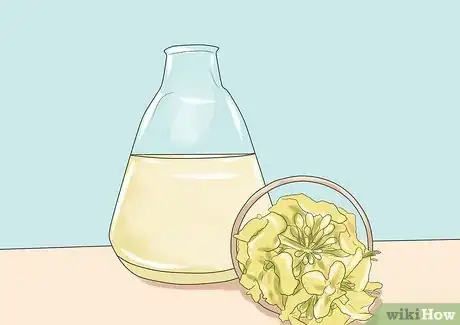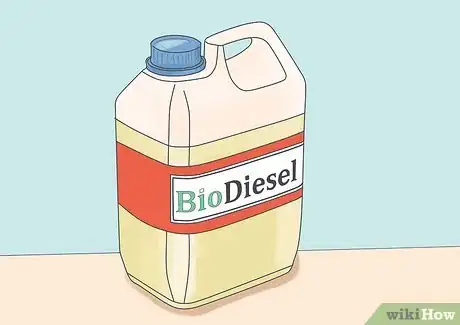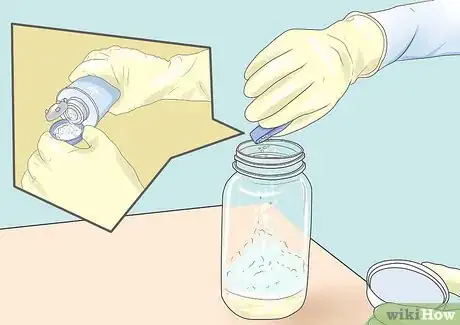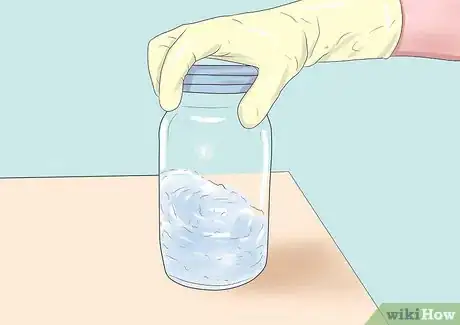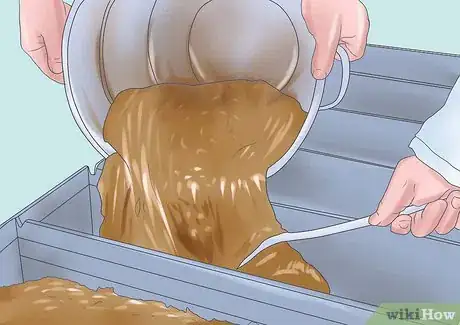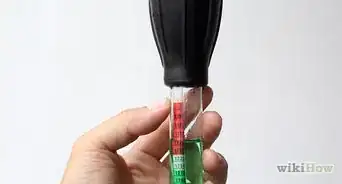wikiHow is a “wiki,” similar to Wikipedia, which means that many of our articles are co-written by multiple authors. To create this article, 23 people, some anonymous, worked to edit and improve it over time.
wikiHow marks an article as reader-approved once it receives enough positive feedback. In this case, 91% of readers who voted found the article helpful, earning it our reader-approved status.
This article has been viewed 268,174 times.
Learn more...
Biodiesel is an alternative fuel for diesel engines made from vegetable oil and/or animal fat. Since it is derived from renewable organic materials and has been shown to reduce certain harmful emissions when burned compared to conventional diesel, biodiesel has received wide attention as a "green" source of energy. Here are steps to synthesize this renewable fuel yourself.
Steps
Preparations
-
1Work in a safe place. This can mean in a clinical laboratory setting. You can find suitable laboratories at most colleges and research institutions. Working at home is also possible but requires caution - manufacturing your own biodiesel may be illegal and can put your house at risk of a fire, smoke or carbon monoxide.
- A good work place will be well-ventilated and have clear access to running water, eye-wash stations, fire extinguishers, spill containment supplies, a fire alarm and a telephone to use in case of emergencies.
-
2Observe laboratory dress codes. Most laboratories will have posted dress instructions you should follow. You should always wear a long-sleeve shirt, long pants, and shoes in any laboratory setting.
- When making biodiesel, you should also wear a heavy-duty apron, chemical-resistant gloves (butyl rubber is best when handling methanol and lye) and protective goggles or eyewear. The gloves should come up to your elbows or have cuffs you can pull over your long-sleeve shirt.
Advertisement -
3Obtain good-quality oil. The easiest oils to use for biodiesel are neutral vegetable oils like canola, corn, and sunflower oil - these oils are readily available at grocery stores and have a low melting point, which means they won't solidify if they get too cold.[1]
- Avoid using peanut oil, coconut oil, palm oil, tallow, and lard. These sources of oil solidify at relatively high temperatures. Biodiesel usually has a lower melting point than the oil it's made from[2] , but these oils can still be difficult for beginners.
- Also avoid olive oil. It, peanut oil, palm oil, tallow, and lard all contain more acids than in the recommended neutral oils. These extra acids can interfere with the reactions that take place to create the biodiesel.
- It's also possible to use waste vegetable oil which has been used for cooking. However, waste oil should be filtered to remove particulates, then allowed to settle for 24 hours to separate the oil from any water or other impurities. Pure oil will be clear and bright, with no sediment.[3]
-
4Ensure all containers are well-labeled. Only use containers for making biodiesel - don't use them for storing food afterwards, even if you wash them well.
Procedure
-
1Add 200 ml methanol to glass blender or mixer. Take care not to splash or spill. Set the blender or mixer to "low".
-
2Add 3.5 grams (0.02 oz) of lye. Try to weigh the lye quickly, as it absorbs moisture from the air. For this reason, be sure tightly seal the container you got the lye from.[4]
- The ensuing reaction between the methanol and lye produces sodium methoxide. Sodium methoxide cannot be allowed to sit for long, as it degrades in the presence of moisture.
-
3Allow the lye to completely dissolve in the methanol. The process should take about two minutes. Proceed when mixture is clear, with no undissolved particles.
- Again, be attentive - the sodium methoxide will degrade rapidly, so proceed to the next step as soon as the lye is completely dissolved.
-
4Heat 1 liter (0.3 US gal) of vegetable oil to 130° F (55° C) Add the hot oil to the mixture. Allow the new mixture to blend for about 20-30 minutes.[5]
- As the reaction proceeds, two products are formed - biodiesel and glycerin.
-
5Pour the mixture into a wide-mouthed glass container or pitcher. Allow the mixture to sit.
- The mixture should separate into two layers - biodiesel and glycerin. Because biodiesel is less dense than glycerin, it should float, forming the top layer.
-
6Allow the mixture to sit for several hours. When it has separated completely, carefully keep the top layer to use as your biodiesel fuel.
- Separate the top layer from the bottom by pouring it off very carefully or using a baster or pump.
-
7Dispose of the glycerin properly. Check with local waste disposal authorities to see whether glycerin can be thrown out with your normal garbage - it usually can.[6]
- If you don't want to waste your glycerin, consider pouring it on a compost heap to increase the rate of decomposition or using it to make soap. Consult our wikiHow on Making Glycerin Soap for more information.
Community Q&A
-
QuestionCan soybean oil be used for making diesel?
 Community AnswerYes, soybean oil is used to make commercial biodiesel and can be used at home for the same purpose.
Community AnswerYes, soybean oil is used to make commercial biodiesel and can be used at home for the same purpose. -
QuestionWhat trees make good bio diesel?
 Community AnswerA tree named Jatropha, which bears fruits, and the seeds of the fruits are used for making bio diesel.
Community AnswerA tree named Jatropha, which bears fruits, and the seeds of the fruits are used for making bio diesel. -
QuestionCan I use groundnut oil to make bio diesel?
 Community AnswerAll naturals oils, fats, greases from vegetable/animal/algae can be used, they just need to be purified, filtered, then dehydrated in order to be use in bio diesel production. The quantity of lye will be estimated with an acid titration test.
Community AnswerAll naturals oils, fats, greases from vegetable/animal/algae can be used, they just need to be purified, filtered, then dehydrated in order to be use in bio diesel production. The quantity of lye will be estimated with an acid titration test.
Warnings
- Lye is corrosive to skin. Keep a bottle of vinegar on hand - in the event you splash any lye on your skin, rinse the area immediately with vinegar to neutralize the chemical, then rinse with water.⧼thumbs_response⧽
- Handle methanol with extreme care. Methanol is the most dangerous chemical used to produce biodiesel. It is extremely flammable and can be caused to burn or explode with a single spark. It is also poisonous and can cause blindness if inhaled or ingested.⧼thumbs_response⧽
- Keep the work area clear of distractions. Do not attempt to synthesize biodiesel around children or animals.⧼thumbs_response⧽
- Do not bring any food or drink into the work area.⧼thumbs_response⧽
- Consult your owner's manual or vehicle manufacturer before using biodiesel in a vehicle. Biodiesel can harm vehicles that are not built to run on it.⧼thumbs_response⧽
Things You'll Need
- Long pants
- Long-sleeve shirt
- Shoes
- Heavy duty apron
- Chemical-resistant gloves
- Protective goggles or eyewear
- 1 liter (0.3 US gal) vegetable oil
- 3.5 grams sodium hydroxide (lye)
- 200 ml methanol
- Glass blender w/low speed option or other glass mixing apparatus
- Digital scale (for measuring 3.5 grams)
- Graduated cylinder or measuring cup (for measuring 200 ml)
- Glass container marked for measuring 1 liter (0.3 US gal)
- Glass container that will hold at least 1.5 liters (0.4 US gal)(2-quart glass pitchers work well)
References
- ↑ https://farm-energy.extension.org/biodiesel-production-principles-and-processes/
- ↑ http://journeytoforever.org/biodiesel_make.html#start
- ↑ http://journeytoforever.org/biodiesel_make.html#start
- ↑ https://www.popularmechanics.com/cars/hybrid-electric/a4717/4332200/
- ↑ https://www.youtube.com/watch?v=TC9h78b2RM4
- ↑ https://www.motherearthnews.com/green-transportation/biodiesel/home-biodiesel-production-zm0z15aszmar
- https://www.sciencedaily.com/releases/2016/04/160420111146.htm
About This Article
To make bio diesel, make sure that you're working in a clinical lab setting such as a laboratory at a college or research institution. Additionally, make sure you wear a heavy-duty apron, chemical-resistant gloves, and protective eyewear. In order to start, mix methanol in a glass blender. Then, add lye to the methanol and allow it to dissolve. While waiting, heat vegetable oil to 130 degrees Fahrenheit, then add it to the mixture and blend it for 30 minutes. Finally, allow the mixture to sit until the biodiesel floats to the top. To learn how to extract the bio diesel from the container, keep reading!


